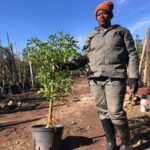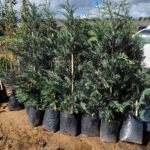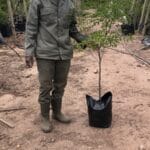Showing 109–111 of 111 resultsSorted by popularity
-
Sale!

Cussonia Spicata 20lt
Original price was: R550.00.R349.99Current price is: R349.99.Add to cartCussonia Spicata 20lt
Common Name: Cabbage TreeFull Sun
Evergreen
Indigenous
Wind TolerantCussonia spicata, commonly known as the cabbage tree, is a species of tree native to parts of southern and eastern Africa, including South Africa, Eswatini (Swaziland), Zimbabwe, Mozambique, and eastern tropical Africa.
🌳 General Description
Family: Araliaceae
Common Names: Cabbage tree, Spiked Cabbage Tree
Height: Typically grows 5–15 meters tall
Growth Form: Often has a single, thick trunk with a sparse, rounded crown🍃 Leaves
Type: Large, leathery, palmately compound (resembling fingers on a hand)
Arrangement: Clusters at the ends of thick branches
Colour: Blue-green to grey-green
Appearance: The leaf shape and arrangement give the tree a cabbage-like look🌸 Flowers and Fruit
Flowers: Small, greenish-yellow, borne in dense, spiky heads on tall, branched stalks
Blooming Season: Late summer to autumn
Fruit: Small, roundish drupe that turns purple when ripe🐘 Ecological Role
Wildlife: Leaves and bark are browsed by elephants and other herbivores
Birds and Insects: Attracted to flowers for nectar and fruit for food -
Sale!

Cupressus Leylandii 20lt
Original price was: R650.00.R399.99Current price is: R399.99.Add to cartCupressus Leylandii 20lt
Common Name: Leyland Cypress Tree
-
Sale!

Caesalpinia Ferrea (Leopard Tree) 20lt
Original price was: R650.00.R439.99Current price is: R439.99.Add to cartCaesalpinia Ferrea 20lt
Common Name: Leopard TreeCaesalpinia ferrea, commonly known as Leopard Tree or Brazilwood, is a species of flowering tree belonging to the Fabaceae family. It is native to various regions in South America.
Appearance: The Leopard Tree is a medium-sized deciduous tree that can reach a height of 10 to 15 meters. It has an open, spreading crown with a rounded or umbrella-like shape. The tree’s bark is distinctive, with a mottled pattern of dark brown and light grey, resembling the coat of a leopard, which is the origin of its common name.
Leaves: The leaves are bipinnately compound, meaning they are divided into smaller leaflets, giving them a fern-like appearance. The leaflets are small and arranged along a central rachis (main axis). The leaves are usually green during the growing season but turn yellow or yellow-green before shedding in the fall.
Flowers: The tree produces small, bright yellow flowers with long stamens that are held in clusters. The flowers are attractive and serve as a nectar source for various pollinators, such as bees and butterflies.
Fruits: After flowering, Caesalpinia ferrea forms elongated pods that contain seeds. These pods are woody and brown in colour.
Habitat: The Leopard Tree is adaptable to various soil types and can thrive in both moist and drier conditions. It is commonly found in tropical and subtropical regions, especially in open woodlands and savannas.
Uses: The wood of Caesalpinia ferrea is durable and has been used for various purposes, including construction, furniture, and tools. In some regions, the tree is also valued for its ornamental qualities and is planted in parks, gardens, and along streets.
